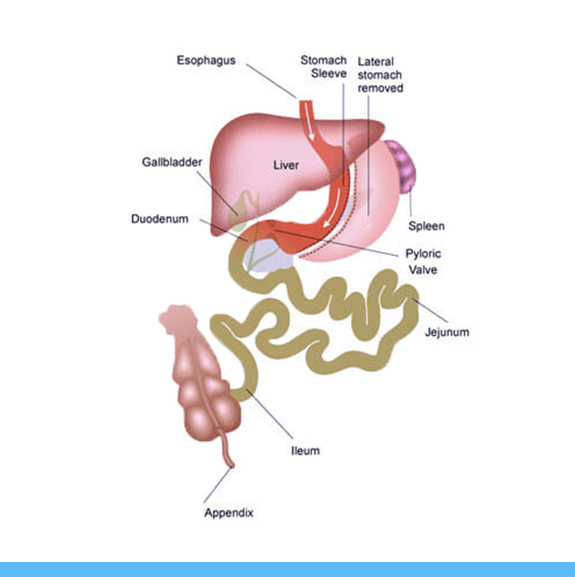Gastric Sleeve in
Tijuana Mexico
Achieve Your Ideal Body Weight With Gastric Sleeve
The vertical sleeve gastrectomy in Mexico is the most popular procedure we offer. Replace the highlighted Link as shown in below Over the past few years, it has gained popularity with men and women wanting to lose weight with bariatric surgery. With this surgery, the digestive tract is not altered only the stomach itself is made smaller. Typical weight loss with the gastric sleeve is 50-60% of excess body weight within the first year post-surgery.
Why Choose Bariatric Surgeries?

Safety:
Gastric sleeve surgery is considered to be one of the safest weight loss surgeries to perform, resulting in significantly fewer complications than gastric bypass. We perform our procedures in top-notch facilities with highly trained staff.
Luxury:
When you sign up for gastric sleeve in Tijuana with ALO Bariatrics, you enjoy concierge service, excellent accommodations, private transportation, and personalized attention from our staff. From the moment you cross the border, we take care of you.

Effectiveness:
Gastric sleeve surgery is highly effective, with most patients losing about half of their excess weight in the first year. It is also a procedure with excellent long-term success in keeping the weight off.

Price:
| Location | Tijuana | Puerto | Guadalajara – Puerta de Hierro |
| Cost | $4,900 | $5,200 | $5,200 |
| Location | Gastric Sleeve |
| Tijuana | $4,900 |
| Puerto Vallarta | $5,200 |
| Guadalajara – Puerta de Hierro | $5,200 |

What is a Gastric Sleeve?
Also known as sleeve gastrectomy, this procedure involves dividing and stapling the stomach vertically. This removes about 85% of the stomach, and the remaining pouch, or sleeve, is about the size of a banana. It restricts the amount of food you can eat and allows for normal digestion and absorption. Functionally, it is like a lap band; however, vertical sleeve gastrectomy doesn't require fills, and the patient typically experiences greater weight loss. However, a gastric sleeve is not reversible, and patients should not consider this option if they are looking for a reversible solution.
Patients looking for cosmetic results may be interested in a single-incision laparoscopic sleeve surgery (SILS). This method utilizes only a single-entry port, typically located in the patient’s navel, leaving only one small scar. Patients with a BMI under 40 who have not had previous gastric surgery may be a candidate for this method.
The nerves to the stomach and the outlet valve (pylorus) remain intact to preserve normal stomach function. The major change is reducing the stomach’s volume. There is no intestinal bypass with this procedure, only stomach reduction. The procedure is appropriate for both low and very high BMI patients.
The surgery also helps to control hunger, reduce appetite, and improve satiety, as the upper portion of the stomach that produces the hunger-stimulating hormone Ghrelin is removed during surgery. This procedure cannot be reversed once it has been done.
Calculate Your Body Mass Index (BMI)
Vertical sleeve gastrectomy is not a quick fix for obesity. It will greatly change your lifestyle. You must eat healthy foods, control portion sizes of what you eat, and exercise after this surgery. If you do not follow these measures, you may have complications from the surgery and poor weight loss.
The Benefits of Weight Loss VSG Surgery in Mexico
Obesity is a disease, and as such, you deserve treatment for it. A high BMI shortens your life expectancy, leads to health complications, and overall reduces your quality of life. While shedding pounds won’t fix every problem, a healthier and happier you is better positioned to tackle all the things that come your way. Here are some of the most notable benefits of gastric sleeve in Tijuana to keep in mind.
- Reduced risk of developing comorbidities like heart disease or diabetes.
- Better health outcomes for those who already have comorbidities.
- Boosted confidence in your appearance and abilities.
- Greater ease in completing work and chores.
- Reduced joint pain and stiffness.
- Increased joy in life.
What to Expect During the Gastric Sleeve Procedure
Step: 01
You will be put under general anesthesia, ensuring we can safely carry out the procedure without you feeling anything. Our anesthesiologist will carefully monitor you.
Step: 02
Strategic incisions will be made. Depending on the approach that is best for you, this may mean making multiple incisions. Open surgery may be required with sleeve surgery in rare cases, but this is unlikely.
Step: 03
Your stomach will be divided into two sections, with the smaller one being shaped into a sleeve and closed. The other portion will be removed from the body, and with it, the part that produces the hunger hormone ghrelin.
Step: 04
Your incisions will be closed and you will be taken to recovery. We will carefully monitor you until you are ready to head to your hotel. At this point, you will have your new, smaller stomach that will help you manage your eating once it has healed.

Are You a Good Candidate for Gastric Sleeve Surgery in Mexico?
To qualify for Gastric Sleeve Surgery, you must:
- Be 18 or older.
- Have a BMI over 35 or a BMI over 30 with a metabolic syndrome (hypertension, diabetes, dyslipidemia).
- Have tried to lose weight through exercise and diet modification.
- Be committed to making the necessary lifestyle changes.
Gastric Sleeve Facts
- Length of Procedure: 1.5 hours
- Average Hospital Stay: 2 nights
- Recommended Time Off Work: 1 -2 weeks
- Typical Weight Loss: 85 – 90% of excess weight in 2 years
Call (619) 653-6739 for Life-Changing Weight Loss Solutions.
Recovering from Gastric Sleeve
Recovery from gastric sleeve surgery, also known as vertical sleeve gastrectomy, is typically a relatively smooth process. The surgery is usually performed as a laparoscopic procedure, using small incisions, a retractable camera, and surgical tools, which results in minimal pain and a shorter recovery time.
Patients can expect a hospital stay of 1 to 3 days, with a full recovery time of 4 to 6 weeks. Time off work is typically 1 to 3 weeks. Pain is managed with medication, and patients can expect a slow transition from clear liquids to solid foods and a slow transition back to regular activity and exercise.
Pre-Op Diet
The pre-op diet for gastric sleeve surgery typically involves a liquid diet for 2-3 weeks before the surgery. This helps to shrink the liver and reduce the risk of complications during the procedure. The higher a patient’s body mass index (BMI) is, the higher their chances of post-operative complications are. By following a pre-op diet, patients can lose weight and decrease their BMI, lowering their risk of complications.
The diet may include protein shakes, clear broths, and non-carbonated water. It is important to follow the specific guidelines the surgeon and dietitian provide. Additionally, patients are advised to avoid smoking, alcohol consumption, and any medications that can cause blood thinning in the weeks leading up to the surgery.
Post-Op Diet
After gastric sleeve surgery, the stomach capacity is only 3 to 4 ounces, down from 60 ounces, which makes every piece of food important in fulfilling nutritional deficiencies patients will face after surgery.
For the first few days to a week after surgery, you’ll be put on on a clear liquid diet consisting only of broth, black decaf coffee or tea, and water.
After the first week, you’ll be able to move to a full-liquid diet consisting of sugar-free nutrition and protein shakes, smooth souls, yogurt, and thin hot cereal. You’ll be given protein goals that you will need to meet in order to ensure proper recovery.
After 2-3 weeks, you’ll be able to eat soft and pureed foods. This includes scrambled eggs, soft ground meat or fish, tofu, and canned fruit. Avoid solid foods, foods high in fiber, and spicy foods.
While reintroducing foods, the post-op diet should consist mainly of fruits, vegetables, lean protein, and healthy carbohydrates. Avoiding unhealthy foods that are high in fat, carbohydrates, and calories, as well as stretching the stomach after surgery, is important to avoid complications. Following gastric sleeve diet guidelines that certified surgeons and nutritionists set is critical for post-op.
Expected Results

The weight loss results can vary depending on the individual’s starting weight, height, and body mass index (BMI).
The average monthly weight loss after gastric sleeve surgery is 8-16 lbs in the first 6 months after surgery. Patients can lose up to 50% of excess weight in the first 6 months. Patients average a 60% decrease in excess weight at the one-year mark and a 65% decrease in excess weight at the 2-year mark.
If you want to lose those unhealthy extra unwanted pounds, weight loss surgery is the fastest and most effective option. Contact us today at (619) 653-6739. Our friendly, knowledgeable coordinators will be happy to answer your questions and schedule your initial consultation with Dr. Alejandro Lopez. During this visit, he will provide you with a comprehensive exam, discuss your weight loss options, and review the benefits of gastric sleeve so that you can reach your ideal weight this year. Call our offices today at (619) 653-6739 or use our contact form for a free weight loss consultation.
Alternative Options
Gastric Bypass
Gastric bypass surgery is a common alternative to gastric sleeve surgery. Both bariatric surgeries aim to promote weight loss by altering the stomach size.
Gastric sleeve surgery removes about 75-80% of the stomach, while gastric bypass surgery creates a small stomach pouch that holds 1 to 2 ounces.
It’s important to note that both gastric sleeve and gastric bypass surgeries are major procedures and should be thoroughly discussed with our bariatric surgeon to understand the risks, benefits, and to determine which surgery is best for you.
Duodenal Switch
Duodenal switch, also known as biliopancreatic diversion with duodenal switch (BPD-DS), is another alternative to gastric sleeve surgery. Both gastric sleeve and duodenal switch are bariatric surgeries that aim to promote weight loss by altering the size of the stomach and/or the small intestine.
Like gastric sleeve surgery, duodenal switch involves removing a portion of the stomach, but unlike gastric sleeve surgery, it also involves rerouting the small intestine to promote malabsorption. The small intestine is divided and rerouted so that the majority of the food bypasses the stomach and upper small intestine, reducing the amount of calories and nutrients that are absorbed.
Duodenal switch can result in more weight loss than gastric sleeve, with some sources stating that patients can expect to lose up to 85% of their excess weight. However, it also carries a higher risk of complications and nutritional deficiencies and requires more careful monitoring of diet and supplements post-surgery monitoring.
Lap-Band
Laparoscopic adjustable gastric banding, or LAP-BAND, is another alternative to gastric sleeve surgery. It is a restrictive bariatric surgery that involves the placement of an adjustable band around the upper portion of the stomach to create a small stomach pouch and slow the passage of food.
The LAP-BAND procedure is considered less invasive than gastric sleeve or duodenal switch, as it does not involve any cutting or stapling of the stomach or small intestine. It is reversible, meaning that the LAP-BAND can be removed at any time.
The weight loss results from LAP-BAND are typically not as dramatic as gastric sleeve or duodenal switch. Still, it can be considered a safer option, with a lower risk of complications and a shorter recovery time.
Frequently Asked Questions About Gastric Sleeve Surgery in Mexico
What Is the Average Cost of the Gastric Sleeve?
The average cost of a gastric sleeve depends on several factors. The average cost of getting a gastric sleeve procedure in the U.S. is around $15,400. However, getting your procedure done in Mexico can be much less expensive, even after you factor in travel, hotel, and hospital fees.
Does Insurance Pay for Gastric Sleeve?
How Long Does It Take to Recover From Gastric Sleeve?
Recovering from gastric sleeve takes about the same amount of time as recovering from gastric bypass. Generally, you’re in hospital at least overnight and need to recover for several days in bed. Within 2 weeks, though, you’re able to return to most normal activities. Exercise and heavy lifting should be postponed until you get your doctor’s opinion.
How Much Weight Can You Expect to Lose With Gastric Sleeve?
Patients, on average, can expect to lose around 50% of their excess body weight in the first year. That is, if a patient’s current weight is 300 pounds, and the weight they want to be at is 150 pounds, they can expect to lose around 75 pounds as a result of the procedure in the first year. Weight loss does plateau over time, though.









